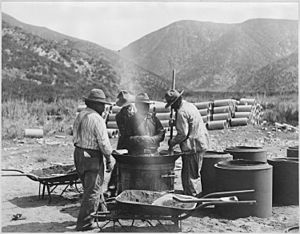Serrano people facts for kids

Workers making pipe turnouts on the Morongo Reservation
|
|
| Total population | |
|---|---|
| over 1000 (1995 or 1998, est.) | |
| Regions with significant populations | |
| Languages | |
| English, Serrano | |
| Religion | |
| traditional tribal religion, Christianity (Moravian) |
|
| Related ethnic groups | |
| Cahuilla and Tongva peoples |
The Serrano are an Native American people who have lived in California for a very long time. They call themselves by different names, like Taaqtam, which means "people." They also use Maarrênga’yam, meaning "people from Morongo", and Yuhaaviatam, meaning "people of the pines." Today, many Serrano people are part of the Morongo Band of Mission Indians and the San Manuel Band of Mission Indians. Some are also enrolled in the Soboba Band of Luiseno Indians.
Historically, the Serrano lived in the San Bernardino Mountains and other mountain ranges in Southern California. They also lived in parts of the southern Mojave Desert.
Contents
The Serrano Language and Name
The Serrano language is part of a larger group called Takic languages, which is a branch of the huge Uto-Aztecan languages family. This language family stretches from Mexico all the way up the West Coast and into the Great Basin. The Serrano people are believed to be a group of Takic language speakers who arrived in Southern California about 2,500 years ago.
The name Serrano means "highlander" or "mountaineer" in Spanish. When Spanish missionaries arrived in the late 1700s, they gave this name to the people living in the mountains. This helped them tell the Serrano apart from nearby tribes like the Tongva and Kitanemuk.
Life Before and During Spanish Contact
Before the Spanish arrived, the Serrano lived in villages and used mountain camps for hunting. Evidence from an old camp near Baldwin Lake shows they used tools like grinding stones and had fire pits, possibly dating back 1,000 years.
In 1771, the Spanish founded Mission San Gabriel Arcangel. This mission was built south of the San Gabriel Mountains, close to Serrano lands. The Spanish claimed these lands and brought them under the mission's control. An outpost called the San Bernardino de Sena Estancia was set up in 1819.
The Serrano, along with the Cahuilla and Quechan tribes, resisted the Spanish missions. In 1812, they took part in a revolt against the missions, which were forcing Native Americans to change their way of life. In 1834, the Mexican government, which then controlled California, forced many Serrano people to move to the missions.
Challenges and New Beginnings
The Serrano people faced very difficult times. They suffered greatly from smallpox outbreaks in 1840 and 1860, which caused many deaths.
In 1867, the Yuhaviatam band of Serrano experienced a violent event involving American settlers. This happened during a 32-day conflict near Chimney Rock. The settlers' actions were a response to a raid on a settlement at Lake Arrowhead, which was likely carried out by Chemehuevi Southern Paiutes. During that raid, buildings were burned, and three ranch workers were killed.
After this difficult period, their leader, Santos Manuel, guided the survivors from the mountains to the valley. They settled permanently near hot springs, close to what is now Highland.
In 1891, the United States government created the San Manuel Reservation for the Serrano people. This reservation was named in honor of Chief Santos Manuel.
Traditional Lands and Villages
The Serrano historically lived in the San Bernardino Mountains and extended into the San Bernardino Valley. Their territory also reached northwest into the Mojave River area of the Mojave Desert. To the west, they lived in the San Gabriel Mountains, the Sierra Pelona Mountains, and the southern Tehachapi Mountains.
Some of their villages included Akxawiet, Cucamonga, Homhoabit, Jurumpa, Juyubit, Muscupiabit, Topapaibit (Victorville), Guapaibit (Hesperia), Paso del Cajon, San Benito, San Gorgonio, San Pascual, San Timoteo, Temeku, Tolocabi, and Yucaipa.
Population Changes Over Time
It's hard for historians to know exactly how many Serrano people lived in California before Europeans arrived. Some experts believe there were about 2,500 Serrano people around 1770.
However, diseases like smallpox and the disruption caused by Spanish missions greatly reduced their numbers. By 1880, the census reported only 381 Serrano people. By 1910, estimates suggested the combined population of Serrano and related groups was around 150.
Serrano Today: Reservations
Today, the Serrano people have two main federally recognized Indian reservations. These are the Morongo Reservation in Banning, California, and the San Manuel Reservation near San Bernardino, California.
See also
In Spanish: Serrano (tribu amerindia) para niños

